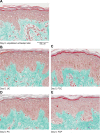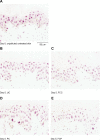Protective effects of a novel facial cream against environmental pollution: in vivo and in vitro assessment
- PMID: 30519068
- PMCID: PMC6237134
- DOI: 10.2147/CCID.S180575
Protective effects of a novel facial cream against environmental pollution: in vivo and in vitro assessment
Abstract
Background: The effects of pollution on health have received increasing attention in recent years. Extrinsic skin aging occurs via multiple processes, and pollution is now recognized as a major component, causing increased pigmentation and wrinkles via oxidative mechanisms. We tested the antipollution efficacy of a cosmetic facial cream (FC) by assessing its effects on carbon particle adhesion to skin and on oxidative and inflammatory pathways in the skin.
Methods: In an in vivo study, FC was applied once to the forearms of healthy subjects. Carbon E153 powder was applied, and the skin was washed under standardized conditions. Images were taken using a dermoscope to determine the area of particle adherence. Each participant served as their own control, with the contralateral forearm being untreated with the FC but otherwise following the same protocol. In a 5-day ex vivo study, skin explants were treated with the FC daily and exposed to vaporized pollutants on day 2 and day 4 via a closed system. Explants were sampled at baseline and day 5 and culture media on day 5. The parameters evaluated were cellular viability on microscopy, Nrf2 immunostaining, malondialdehyde (MDA) levels in culture, melanin levels, and gene expression profile (TYR, IL6, and CYP1A1).
Results: In the in vivo adhesion study, after standardized washing, carbon particle deposition on skin treated with the FC was significantly lower than that on untreated skin. In the ex vivo study, samples treated with the FC had reduced Nrf2 staining and MDA levels vs polluted controls. Melanin did not change significantly. The FC modulated pollution-induced increases in CYP1A1, IL-6, and TYR.
Conclusion: This FC reduces particle adhesion to skin after a single application and protects against pollution-induced oxidative and inflammatory pathways in the skin.
Keywords: Nrf2; TYR; barrier; exopolysaccharide; genomic; pollution; shield; skin aging.
Conflict of interest statement
Disclosure MN, GB, PV, and CG are employees of ISDIN S.A, the manufacturer of the cosmetic product tested in this study. The authors report no other conflicts of interest in this work.
Figures



References
-
- Pilz V, Wolf K, Breitner S, et al. C-reactive protein (CRP) and long-term air pollution with a focus on ultrafine particles. Int J Hyg Environ Health. 2018;221(3):510–518. - PubMed
-
- WHO [homepage on the Internet] Air Quality Guidelines for Particulate Matter, Ozone, Nitrogen Dioxide and Sulfur Dioxide, Global Update 2005. Summary of Risk Assessment. 2006. [Accessed September 18, 2018]. Available from: http://www.who.int/phe/health_topics/outdoorair/outdoorair_aqg/en/
-
- Baudouin C, Charveron M, Tarroux R, Gall Y. Environmental pollutants and skin cancer. Cell Biol Toxicol. 2002;18(5):341–348. - PubMed
LinkOut - more resources
Full Text Sources

